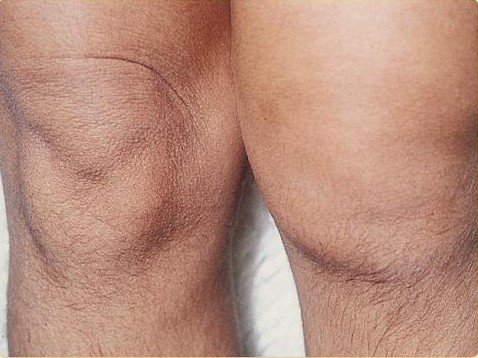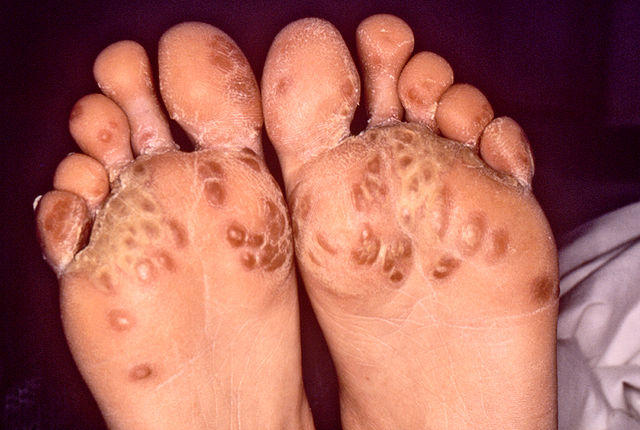Reactive Arthritis (ReA) or Reiter Syndrome
What is reactive arthritis?
Reactive arthritis is a condition of the joints that arises with gastrointestinal or genitourinary infections. It may also involve the skin and eyes. These manifestations at the joint, skin or eyes are not due an infection at these sites. Instead it is an immune response associated with an infection of the gut, urinary tract or reproductive organs and sometimes the respiratory system. Reactive arthritis tends to arise as late as 2 to 4 weeks after the infection.
What is Reiter syndrome?
Reactive arthritis is also known as Reiter syndrome, named after Hans Reiter who first described the condition in 1916. However, the term reactive arthritis is preferred over Reiter syndrome. In fact Reiter syndrome is one specific type of reactive arthritis where there is inflammation of the joint (arthritis), eye (conjunctivitis) and urethra (urethritis) in Shigella dysentery. In reactive arthritis the joint alone may be involved at times and there are various other bacteria that can serve as a trigger.
Arthritis with Infections
Arthritis is the medical term for joint inflammation which can occur for various reasons. For example, injury to a joint leading to inflammation is known as traumatic arthritis or infection of the joint is septic arthritis. Reactive arthritis is a separate type of arthritis where there is joint inflammation as a result of infection.
The joint itself is not infected in reactive arthritis. Instead the infection is elsewhere in the body and the joint inflammation is a reaction to this infection. Therefore it is known as reactive arthritis. Although joint pain (arthralgia) can occur with certain infections, particularly systemic viral infections, it is not the same as reactive arthritis.
The condition is more likely to be seen with bacterial infections of the gastrointestinal system (stomach and intestines) or genitourinary system (reproductive organs, kidney and urinary tract). It rarely occurs with infections of other systems although it has been linked to certain types of respiratory infections.
The reason for this joint reaction in reactive arthritis is not clearly understood. It is known that the joint is not infected but there seems to be an increase in the infection-fighting immune cells, antibodies and even bacterial antigens within the affected joint. Therefore its seems that reactive arthritis is an immune-mediated condition where the synovial lining of the joint becomes inflamed (synovitis).
There may also be inflammation of the skin, mucous membrane of the eyes, urethra or mouth and sometimes the tendons of muscles along with joint inflammation in reactive arthritis.
Location of Arthritis
Reactive arthritis can involve several joint simultaneously. Any joint may be involved. Pain is more common in certain joints while swelling is more evident in those joints close to the skin surface. The more commonly affected joints include :
- Knees
- Ankles
- Toes
- Fingers
- Lower back
- Buttocks
Less commonly, the shoulders, wrists and elbows may be affected.
When do symptoms appear?
The symptoms of reactive arthritis tends to arise between 2 to 4 weeks after the infection in the gastrointestinal or genitourinary system. It can arise as early as 1 week or as late as 6 weeks thereafter. The long duration after the infection can sometimes prove to be misleading as the symptoms may not be correlated with the preceding infection. Initially there is the symptoms of the original infection and this often resolves by the time the symptoms of reactive arthritis become evident. Just before the joint symptoms, there may be fever and malaise.
ReA Joint Symptoms
- The weight bearing joints are more commonly affected.
- Several joints are usually involved simultaneously – oligoarthritis.
- There is pain and swelling which can vary in severity.
- Stiffness may sometimes precede the onset of the inflammatory symptoms.
- Swelling is more evident over the superficial joints like the knee.
- Asymmetric joint involvement usually meaning that only the joint on one side is affected.
- Tendon and ligament involves immediately surrounding the affected joint.
Picture of reactive arthritis of the knee from Wikimedia Commons
Other ReA Symptoms
Eyes
- Conjunctivitis (“pink eye”)
- Keratitis and sometimes corneal ulcers
- Uveitis
Mouth
- Mouth ulcers (aphthous stomatitis)
- Geographic tongue
Skin
- Reddish skin rash that is sometimes itchy
- Small nodules on the soles or palms (keratoderma blennorrhagica)
- Thickening and crumbling of the nails
Picture of keratoderma blennorrhagica from Wikimedia Commons
Reproductive and Urinary
The genitourinary system may be involved in reactive arthritis even if the infection is not at this site.
- Urinary symptoms – pain/burning on urination, urinary frequency.
- Urethritis
- Prostatitis
- Cervicitis
Causes
The cause of reactive arthritis is mainly an infection of the gastrointestinal system or genitourinary system but in about 10% of patients there is no infection yet reactive arthritis occurs. It appears that people who develop reactive arthritis have a genetic predisposition to the condition. About 75% of patients who develop reactive arthritis have the HLA-B27 gene.
Bacteria that cause reactive arthritis
Reactive arthritis tends to occur with an infection involving one of the following species of pathogens :
- Genitourinary system :
– Chlamydia - Gastrointestinal system :
– Campylobacter
– Salmonella
– Shigella
– Yersinia - Respiratory system (uncommon) :
– Chlamydophila pneumoniae
Other bacteria which have been proposed to be involved in reactive arthritis includes Ureaplasma urealyticum and Mycobacterium tuberculosis. The more common pathogens involved in reactive arthritis are either contracted through sexual contact (Chlamydia) or by consuming contaminated food or water (Campylobacter, Salmonella, Shigella and Yersinia). Although bacteria appears to be the main pathogen, it appears that some viruses can also trigger reactive arthritis.
Tests and Diagnosis for Reactive Arthritis
Reactive arthritis is diagnosed on the basis of the clinical signs and patient’s report of symptoms along with a history of a gastrointestinal or genitourinary infection. Often other forms of arthritis need to be excluded if only joint symptoms are present. Therefore the diagnosis of reactive arthritis is often missed at the outset. Although there is no specific test to diagnose reactive arthritis, various blood tests should be conducted such as a complete blood count (CBC), erythrocyte sedimentation rate (ESR) and C-reactive protein (CRP).
Needle aspiration of synovial fluid may be helpful in excluding other types of arthritis. Imaging studies such as an x-ray or magnetic resonance imaging (MRI) may also be conducted. Genetic testing for HLA-B27 antigen may also be helpful although it is not present in about 1 out of 4 patients with reactive arthritis. Due to the similarity of symptoms with rheumatoid arthritis and autoimmune diseases, blood tests for rheumatoid factor (RF) and anti-nuclear antibody (ANA) should also be considered.
Reactive Arthritis Treatment
There is no specific treatment for reactive arthritis that will immediately resolve the condition. Reactive arthritis can persist for anywhere from a few weeks to several months. Treatment involves medication and physical therapy and there are no surgical procedures for treating reactive arthritis.
- Nonsteroidal anti-inflammatory drugs (NSAIDs) eases pain and inflammation.
- Antibiotics may be prescribed to treat the initiating infection although it may have already resolved by the time of onset of reactive arthritis.
- Corticosteroids are very potent agents at suppressing inflammation but should be reserved only for severe cases.
- Tumor necrosis factor (TNF) blockers may also be used for reducing inflammation but should only be used in severe and prolonged cases.
- Physical therapy maintains joint mobility, prevents muscle wasting and assist with pain management during the course of the condition.
References :
www.mayoclinic.com/health/reactive-arthritis/DS00486







